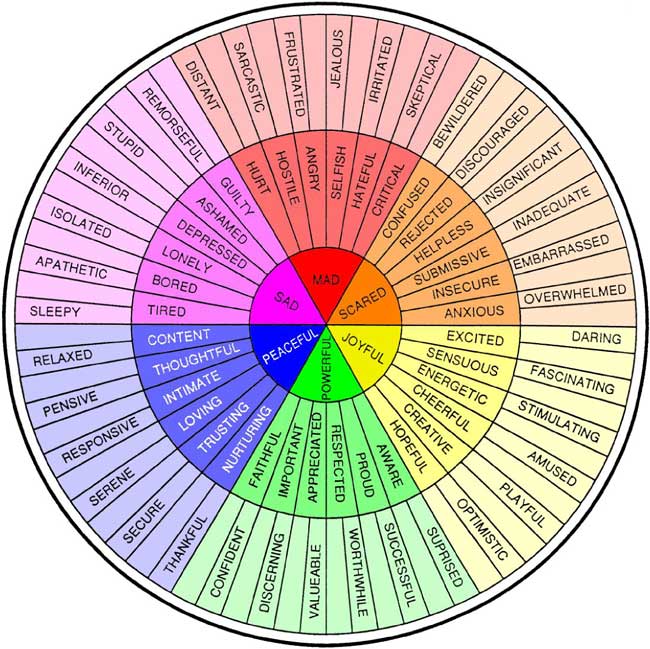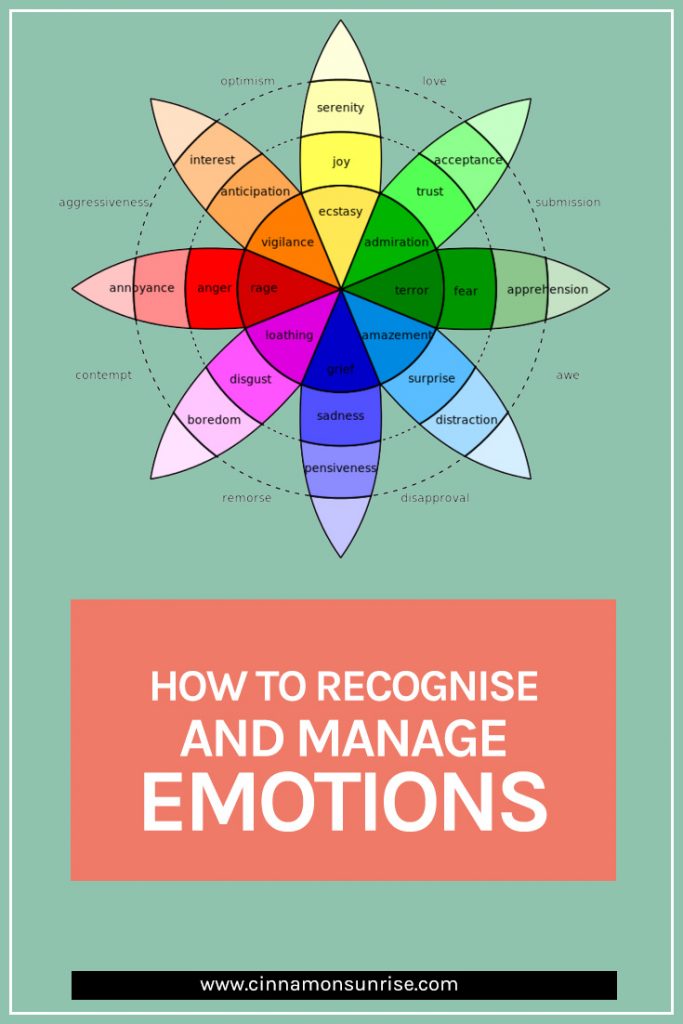This post may contain affiliate links. If you click on an affiliate link and buy something, I get a percentage of the sale. Find out more by reading my affiliate policy and disclosure.
Being a grown-up is all about managing things.
- Managing our time.
- Managing our energy.
- Managing our emotions.
- Managing our physical health.
- Managing our money.
- Managing our environment.
If you can successfully manage all these things, congratulations! You have won at being a grown-up. Leave a comment below to receive your certificate.
Chances are, however, that you struggle with one or more of these areas. Most of us are a work-in-progress 🙂
Today I will focus on one of these that often gets overlooked. That is: how to recognise and manage our emotions.
What are emotions?
Before you can recognise and manage your emotions, you need to understand what emotions actually are. Emotions are both a physiological response to a situation and a cognitive state.
Emotions are easy to understand as a physiological response. Fear, for example, is a sensible reaction to seeing a large predator. We’re all familiar with the idea of fight-or-flight.
However, emotions also come about because of a complex set of beliefs, habitual thinking, memory and cultural expectations. Guilt, for example, is a complex emotion that is (at least partly) rooted in how we are raised.
Emotions can tell us important things about our environment and situation. Chronic feelings of sadness, fear, anxiety or anger may indicate there’s something wrong with our life. Maybe we are in a stressful job, maybe we are in an abusive relationship, or maybe we are lonely and haven’t noticed.
Emotions can also be distracting, unhelpful things. A bit of anxiety before a job interview can sharpen us up and make us more alert – but a full blown panic attack is disproportionate and unhelpful.
How to recognise your emotions
Most of us can recognise when we’re overwhelmed with sadness, when we’re scared by something, when we’re angry, and when we’re filled with joy.
However, these core emotions are building blocks of more complex or more subtle emotions that are harder to unpick.

The above is a diagram constructed by Robert Plutchik that visualises eight basic emotions, plus eight derivative emotions composed of two basic ones.
Some people argue that there are only two basic emotions – love and fear – and that all other emotions are derived from these.
Others have argued that there are anything between six and eight basic emotions from which other, more complex emotions, are derived.
We can surmise that emotions are quite a subjective experience!

A wheel with six basic emotions and higher levels of more nuanced feelings.
It is difficult to identify feelings that you have been taught to ignore or repress. Anger, sadness and frustration are emotions we are often penalised for as children. As such, we can end up repressing them.
(This often runs along gender lines, with women being taught not to express anger and men being taught not to express sadness or fear.)
Just to make things even more difficult, it is entirely possible to feel two or more emotions at the same time. You might be anxious about an exam that’s coming up, but happy about the fact you’re out in the sunshine. Or, you might have a background hum of sadness, whilst still feeling ambitious and optimistic about your future.
How to manage your emotions
For the most part, emotions are transient and don’t need to be ‘managed’. You have anxiety about an exam, you take the exam, you pass and you move on with your life. Or you feel joyful during a picnic on a summer day, enjoy hanging out, and then pack up and go home.
However, there are two things that can happen that cause us problems in our day-to-day life.
Firstly, we can get ‘stuck’ in an emotion. We’re afraid all the time and it stops us from doing the things we want to do. Or we’re angry all the time and keep losing our temper at every little thing. Or, yes, we’re overly optimistic all the time, and as such fail to prepare adequately for life’s challenges.
Secondly, we can express our emotions in destructive ways. We express our anger by punching people, or we react to sadness by drowning our sorrows in alcohol. Our emotions become so powerful that they override our common sense and cause us to make stupid decisions. We make these decisions to alleviate uncomfortable emotions in the short term… but then in the long term we end up worse than before.
These are two quite different problems with different solutions, so let’s look at them separately.
What to do when you are ‘stuck’ with an emotion.
Firstly, take some time to sit quietly and think about how you are feeling.
Take the core emotion – whether that is sadness, anger, fear or anything else – and break it apart into the more nuanced emotions beneath it.
For example: are you angry all the time because you feel overlooked and unrecognised? Are there particular situations or moments in time that have made you feel that way? Why did it make you feel that way? What made it important that you be recognised for that specific thing?
Keep asking questions and keep digging deeper. You will want to write it out into a journal, or talk it through with a trusted friend or a counsellor. This kind of emotional detective work often ends up exposing a lot of your unconscious belief system in the process, and this can take time and effort to unpick.
Then, find a way to acknowledge and express the emotion. If you’re angry, write out a list of the things you know are at the root cause of your anger and burn it. If you’re sad, light a candle for the memory or thing that you’re mourning.
What to do when you feel controlled by your emotions
What about when your emotions are so powerful that you find yourself engaging in destructive behaviours?
Being an emotional person is no bad thing. The ability to recognise what we feel and respond appropriately is a great one. Being able to grieve, laugh, love, share joy, rage over injustice and fear death is what makes us human. It’s what creates empathy and bonds us together.
However, as grown ups, we are all responsible for regulating and managing our emotions so that they don’t cause harm to those around us. If you let powerful emotions dictate your every action you can destroy relationships, find yourself addicted to harmful substances, or become unable to function in society.
It’s important to recognise the difference between the emotion you feel, and the action you take to express that emotion. The first you have relatively little control over, all emotions are valid responses. The second is much more under your control, and it’s up to you to express your emotions in healthy, positive ways.
So, how do you learn to recognise and manage your emotions in a positive way?
There are only two steps to recognising and managing your emotions.
Firstly, learn to wait them out. Most emotions take around 90 seconds to active your limbic system and then dissipate. Take ten deep breaths before you respond to give your emotions time to subside.
Secondly, swap your unhealthy coping strategies with healthy ones.
- Instead of reaching for alcohol, take a walk outside.
- Instead of punching someone, go for a run.
- Instead of tearfully accusing someone of misbehaviour, write a journal entry.
- Instead of launching into a cycle of negative self-talk, call a friend.
Healthy ways of coping with your emotions have a lot of overlap with other forms of self-care.
Cognitive Behaviour Therapy (CBT) is a great tool for identifying your emotional triggers and replacing the destructive thoughts that lead to negative feelings and behaviour.
You can also find a number of apps and online tools to help you recognise and manage your emotions.
You are not your emotions
Emotions are a tool. A powerful tool, with a lot to teach us, but still just a tool. It is up to us to maintain awareness of our emotions and manage them appropriately. The way you feel is always valid, and you shouldn’t judge yourself for feeling a negative emotion, but the way you respond is under your control.
Take your time to work out what is going on and then decide on your best course of action. Recognise and manage your emotions to live your best life.
Pin for later!
